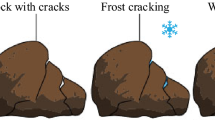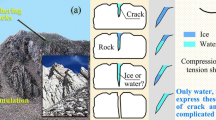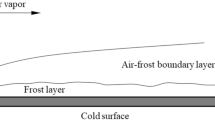Abstract
Ice-driven mechanical weathering in mountainous environment is considered as an efficient process for slow but cyclical mechanical preconditioning of rockfall events. In this study, we simulate subcritical microfracture propagation under frost wedging conditions along pre-existing mechanical weaknesses of intact rock bridges with an innovative experimental approach. Two series of freeze–thaw experiments conducted in an environmental chamber were carried out to investigate and monitor the propagation of artificially induced fractures (AIF) in two twin gneiss samples. A displacement sensor recorded the sample’s in situ deformation in an environmental chamber during the experiments. 3D X-ray CT scans, performed before and after the experiments, as well as thin sections showing the post-experiment state of the deformed samples allowed tracking and quantification of fracture propagation. Our results demonstrate that frost wedging propagated the AIFs 1.25 cm2 and 3.5 cm2 after 42 and 87 freeze–thaw cycles, respectively. The experiments show that volumetric expansion of water upon freezing, cooperating with volumetric thermal expansion and contraction of the anisotropic rock, plays a key role in fracture widening and propagation. Based on these results, this study proposes that: (1) frost wedging exploits intrinsic pre-existing mechanical anisotropies of the rock; (2) the fracturing process is not continuous but alternates between stages of fast propagation and more quiet stages of stress accumulation; and (3) downward migration of “wedging grains,” stuck between the walls of the fracture, increases the tensile stress at the tip, widening and propagating the fractures with each freeze–thaw cycle. The experimental design developed in this study offers the chance to visualize and quantify the long-term efficiency of frost wedging in near-natural scenarios.










Similar content being viewed by others
References
Bambauer HU, Herwegh M, Kroll H (2009) Quartz as indicator mineral in the Central Swiss Alps: the quartz recrystallization isograd in the rock series of the northern Aar massif. Swiss J Geosci 102(2):345–351
Berger A, Wehrens P, Lanari P, Zwingmann H, Herwegh M (2017) Microstructures, mineral chemistry and geochronology of white micas along a retrograde evolution: an example from the Aar massif (Central Alps, Switzerland). Tectonophysics 721:179–195
Church M, Stock RF, Ryder JM (1979) Contemporary sedimentary environments on Baffin Island, N. W. T., Canada: debris slope accumulations. Arct Alp Res 11(4):371–401
Davidson GP, Nye JF (1985) A photoelastic study of ice pressure in rock cracks. Cold Reg Sci Technol 11(2):141–153
Eberhardt E, Stead D, Coggan JS (2004) Numerical analysis of initiation and progressive failure in natural rock slopes—the 1991 Randa rockslide. Int J Rock Mech Min Sci 41(1):69–87
Einstein HH, Veneziano D, Baecher GB, O’reilly KJ (1983) The effect of discontinuity persistence on rock slope stability. Int J Rock Mech Min Sci Geomech Abstr 20(5):227–236
Gruber S, Haeberli W (2007) Permafrost in steep bedrock slopes and its temperature-related destabilization following climate change. J Geophys Res Earth Surf 112:148–227. https://doi.org/10.1029/2006JF000547
Hales TC, Roering JJ (2007) Climatic controls on frost cracking and implications for the evolution of bedrock landscapes. J Geophys Res Earth Surf 112:F02033. https://doi.org/10.1029/2006JF000616
Hall K, Thorn C (2011) The historical legacy of spatial scales in freeze–thaw weathering: misrepresentation and resulting misdirection. Geomorphology 130(1–2):83–90
Hallet B (2006) Why do freezing rocks break? Science 314(5802):1092–1093
Hallet B, Walder JS, Stubbs CW (1991) Weathering by segregation ice growth in microcracks at sustained subzero temperatures: verification from an experimental study using acoustic emissions. Permafrost Periglac Process 2(4):283–300
Jia H, Leith K, Krautblatter M (2017) Path-dependent frost-wedging experiments in fractured, low-permeability granite. Permafrost Periglac Process 28(4):698–709
Kemeny J (2005) Time-dependent drift degradation due to the progressive failure of rock bridges along discontinuities. Int J Rock Mech Min Sci 42(1):35–46
Krähenbühl R, Nänni C, Donauet F (2018) Prozesse die zu grossen Fels- und Bergsturz führen. Swiss Bull 23(1):29–56
Matsuoka N (1995) A laboratory simulation on freezing expansion of a fractured rock: preliminary data. Annual report of the Institute of Geoscience, The University of Tsukuba, vol 21, pp 5–8
Matsuoka N (2001a) Direct observation of frost wedging in alpine bedrock. Earth Surf Process Landf 26(6):601–614
Matsuoka N (2001b) Microgelivation versus macrogelivation: towards bridging the gap between laboratory and field frost weathering. Permafrost Periglac Process 12(3):299–313
Nicholson DT, Nicholson FH (2000) Physical deterioration of sedimentary rocks subjected to experimental freeze–thaw weathering. Earth Surf Proc Land 25(12):1295–1307
Phillips M, Wolter A, Lüthi R, Amann F, Kenner R, Bühler Y (2017) Rock slope failure in a recently deglaciated permafrost rock wall at Piz Kesch (Eastern Swiss Alps), February 2014. Earth Surf Proc Land 42(3):426–438
Rapp A (1960) Recent development of mountain slopes in Kärkevagge and surroundings, northern Scandinavia. Geogr Ann 42(2–3):65–200
Savi S, Delunel R, Schlunegger F (2015) Efficiency of frost-cracking processes through space and time: an example from the eastern Italian Alps. Geomorphology 232:248–260
Scavia C, Castelli M (1996) Analysis of the propagation of natural discontinuities in rock bridges. In: ISRM international symposium-EUROCK 96. International Society for Rock Mechanics and Rock Engineering
Tharp TM (1987) Conditions for crack propagation by frost wedging. Geol Soc Am Bull 99(1):94–102
Tricart J (1956) Etude expérimentale du problème de la gélivation. Biuletyn Peryglacjalny 4:285–317
Walder J, Hallet B (1985) A theoretical model of the fracture of rock during freezing. Geol Soc Am Bull 96(3):336–346
Weber S, Beutel J, Faillettaz J, Hasler A, Krautblatter M, Vieli A (2017) Quantifying irreversible movement in steep, fractured bedrock permafrost on Matterhorn (CH). Cryosphere 11(1):567–583
Wehrens P, Berger A, Peters M, Spillmann T, Herwegh M (2016) Deformation at the frictional-viscous transition: Evidence for cycles of fluid-assisted embrittlement and ductile deformation in the granitoid crust. Tectonophysics 693:66–84
Wehrens P, Baumberger R, Berger A, Herwegh M (2017) How is strain localized in a meta-granitoid, mid-crustal basement section? Spatial distribution of deformation in the central Aar massif (Switzerland). J Struct Geol 94:47–67
Worster MG, Wettlaufer JS (1999) The fluid mechanics of premelted liquid films. In: Shyy W, Narayanan R (eds) Fluid dynamics at interfaces. Cambridge University Press, Cambridge, pp 339–351
Acknowledgements
We are particularly grateful to Nouryon Chemicals AG, Dr. Roger Zurbriggen and the assistance of Erwin Bühler that allowed us to perform our experiments in environmental chamber among their laboratories. We gratefully acknowledge Christoph Neururer for his supervision during 3D X-ray CT scanning at the University of Fribourg as well as Thomas Aebi and Stephan Brechbühl for thin-section preparation. Prof. Fritz Schlunegger and Sofia Locchi are thanked for informally reviewing an earlier version of this manuscript and their valuable suggestions.
Author information
Authors and Affiliations
Corresponding author
Additional information
Publisher's Note
Springer Nature remains neutral with regard to jurisdictional claims in published maps and institutional affiliations.
Electronic supplementary material
Below is the link to the electronic supplementary material.
Rights and permissions
About this article
Cite this article
Musso Piantelli, F., Herwegh, M., Anselmetti, F.S. et al. Microfracture propagation in gneiss through frost wedging: insights from an experimental study. Nat Hazards 100, 843–860 (2020). https://doi.org/10.1007/s11069-019-03846-3
Received:
Accepted:
Published:
Issue Date:
DOI: https://doi.org/10.1007/s11069-019-03846-3




